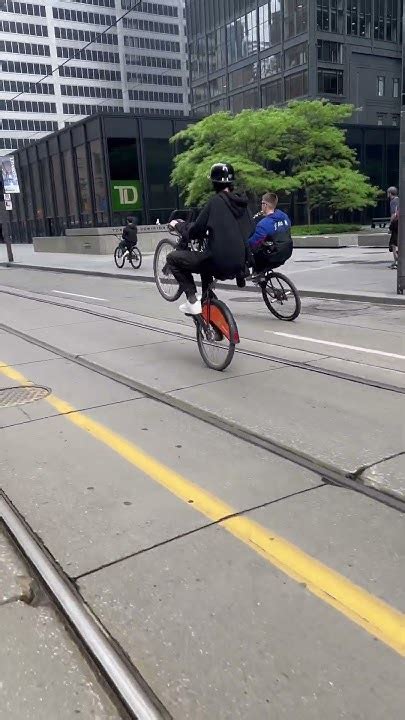The thrill of witnessing a vehicle perform a wheelie in the city is a sight to behold. For those unfamiliar, a wheelie is a stunt where a vehicle, typically a motorcycle or a bicycle, is ridden on its rear wheel while the front wheel is lifted off the ground. This daring feat requires a great deal of skill, balance, and practice, making it a coveted trick among thrill-seekers and adrenaline junkies.
In urban areas, the sight of a wheelie can evoke a range of reactions, from awe and excitement to concern and alarm. Some onlookers might view it as a reckless display of bravado, while others might see it as an impressive demonstration of riding skills. However, it’s essential to acknowledge the potential risks associated with performing wheelies in the city. The presence of pedestrians, cars, and other obstacles can make it a hazardous environment for such stunts.
Despite the risks, many enthusiast communities have emerged, with riders sharing their experiences, tips, and techniques for mastering the art of wheelies. Online forums and social media platforms are filled with videos and stories of riders pushing the limits of what’s possible on two wheels. These communities often emphasize the importance of safety, encouraging riders to wear proper gear, including helmets, gloves, and protective clothing, and to practice in controlled environments before attempting wheelies in urban areas.
From a technical standpoint, performing a wheelie requires a deep understanding of the vehicle’s dynamics and the rider’s ability to make subtle adjustments in real-time. The process involves a delicate balance of throttle control, weight distribution, and body positioning. As the rider accelerates, they must shift their weight rearward, applying gentle pressure to the rear wheel while easing off the front wheel. This subtle interplay between the rider and the vehicle allows the front wheel to lift, and the bike to balance on its rear wheel.
Interestingly, the physics behind wheelies can be applied to various fields, including robotics and autonomous vehicles. Researchers have been studying the dynamics of wheelies to develop more advanced control systems for robots and self-balancing vehicles. By understanding the intricacies of balance and stability, engineers can design more agile and responsive machines.
In addition to the technical aspects, the cultural significance of wheelies in the city cannot be overstated. For many riders, performing a wheelie is a rite of passage, a symbol of their skills and dedication to the craft. The thrill of executing a perfect wheelie can be exhilarating, providing a sense of accomplishment and pride. Moreover, the shared experience of witnessing a wheelie can create a sense of community among onlookers, fostering a sense of camaraderie and shared excitement.
However, it’s crucial to acknowledge the potential consequences of performing wheelies in urban areas. The risk of accidents, injuries, and property damage is ever-present, and riders must be aware of their surroundings and the potential impact of their actions on others. Furthermore, law enforcement agencies often view wheelies as a form of reckless behavior, and riders may face fines, penalties, or even arrest for performing such stunts in public.
To mitigate these risks, many cities have established designated areas for riders to practice and perform wheelies, such as skate parks or closed-course tracks. These controlled environments provide a safer space for riders to hone their skills, reducing the likelihood of accidents and minimizing the impact on public safety.
In conclusion, the phenomenon of wheelies in the city is a complex issue, involving technical, cultural, and social aspects. While it’s essential to acknowledge the potential risks and consequences, it’s also important to recognize the significance of wheelies as a form of self-expression and a demonstration of riding skills. By promoting a culture of safety, responsibility, and respect for the environment, riders and onlookers can coexist and appreciate the thrill of wheelies while minimizing the risks associated with this exhilarating stunt.
What are the key factors to consider when performing a wheelie in the city?
+When performing a wheelie in the city, it's essential to consider factors such as safety, traffic conditions, and the presence of pedestrians and other obstacles. Riders should also be aware of local laws and regulations regarding reckless behavior and ensure they are wearing proper protective gear.
How can riders practice wheelies safely in urban areas?
+Riders can practice wheelies safely in urban areas by finding designated spaces, such as skate parks or closed-course tracks, and wearing proper protective gear. They should also start with low-speed maneuvers and gradually increase their speed as they become more comfortable and confident in their abilities.
What are the potential consequences of performing wheelies in the city?
+The potential consequences of performing wheelies in the city include accidents, injuries, and property damage. Riders may also face fines, penalties, or arrest for reckless behavior. Furthermore, the risk of harming others, including pedestrians and other road users, is ever-present and should not be taken lightly.
As the world of wheelies continues to evolve, it’s essential to strike a balance between the thrill of performing this stunt and the need for safety and responsibility. By promoting a culture of awareness, respect, and caution, riders and onlookers can coexist and appreciate the art of wheelies while minimizing the risks associated with this exhilarating phenomenon.



